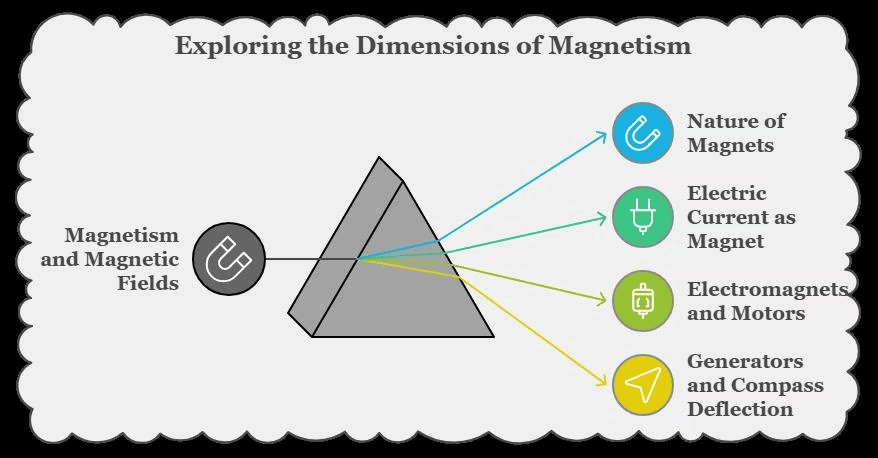Important Definitions and Equations: Magnetic Effects of Electric Current | Science Class 10 PDF Download
| Table of contents |

|
| Magnetism and Magnetic Fields |

|
| Right Hand Thumb Rule |

|
| Magnetic Field due to Current through a Straight Conductor |

|
| Permanent Magnet |

|
| Electric Motor |

|
Magnetism and Magnetic Fields
- A magnet is any material that attracts iron or similar substances. A magnetic field is the area around a magnet where its force can be felt.
- A wire carrying an electric current acts like a magnet. The needle of a compass moves because of the magnetic field from the current-carrying wire.
- Electromagnets and electric motors use the magnetic effects of electric current, while electric generators use the effects of moving magnets.
- Compass needles get deflected when an electric current passes through a metallic conductor.

Right Hand Thumb Rule
This rule helps find the direction of the magnetic field around a wire carrying current.
Magnetic Field due to Current through a Straight Conductor
- Magnetic field lines around a straight conductor form concentric circles at each point.
- Magnetic field strength is proportional to the current's strength and inversely proportional to the distance from the conductor.
Magnetic Field due to Current through a Circular Loop
- Magnetic field lines around a circular loop form concentric circles that expand with distance.
- The direction of the magnetic field inside the loop is the same.
Factors Affecting Magnetic Field of a Circular Conductor
- Magnetic field strength is proportional to the current, inversely proportional to the distance, and directly proportional to the number of turns in the coil.
- Magnetic fields of multiple loops add up due to the specific direction of the current in each circular turn.
Solenoid
- A solenoid is a coil of many circular turns of insulated copper wire wrapped closely in a cylindrical form.
- The magnetic field of a solenoid is similar to that of a bar magnet and is uniform inside.
- The direction of the magnetic field is from North to South outside and from South to North inside the solenoid.

Permanent Magnet
A permanent magnet is not easily demagnetised, has a constant strength and polarity, and can be a very strong magnet.
Force on a Current-Carrying Conductor in a Magnetic Field
- The magnet exerts an equal and opposite force on a current-carrying conductor.
- Maximum displacement occurs when the current is perpendicular to the magnetic field.
Fleming's Left Hand Rule
Describes the direction of the force on a current-carrying conductor in a magnetic field.
Fleming's Right Hand Rule
Used to determine the direction of induced current in electromagnetic induction.
Electric Motor
Converts electrical energy into mechanical energy using a rotating coil in a magnetic field.
Electric Generator
An electric generator uses mechanical energy to turn a conductor in a magnetic field to create electricity through electromagnetic induction.
Alternate Current (A.C.) and Direct Current (D.C.)
Alternating Current (A.C.) changes direction regularly, while Direct Current (D.C.) flows in one direction only.
|
80 videos|569 docs|80 tests
|
FAQs on Important Definitions and Equations: Magnetic Effects of Electric Current - Science Class 10
| 1. What is the Right Hand Thumb Rule and how is it used to determine the direction of magnetic fields? |  |
| 2. How does a straight conductor produce a magnetic field and what is its shape? |  |
| 3. What is a permanent magnet and how does it differ from an electromagnet? |  |
| 4. What are the main components of an electric motor and how does it utilize magnetic effects? |  |
| 5. What are the key definitions related to the magnetic effects of electric current that students should know for Class 10? |  |





















